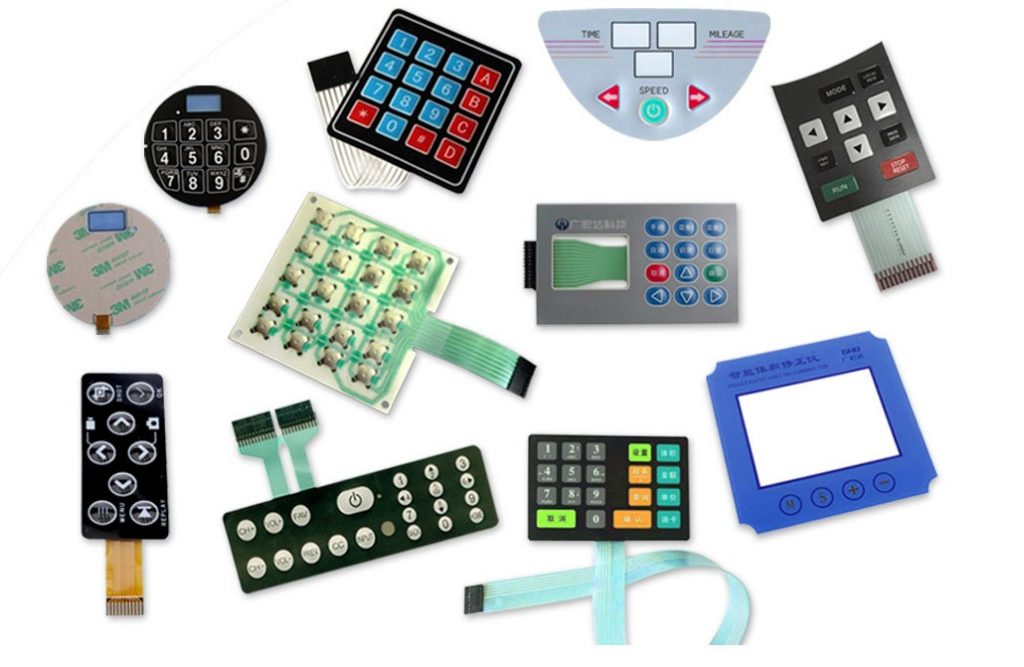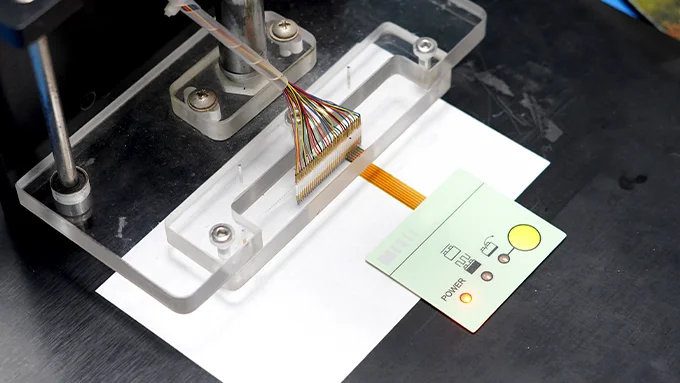The Manufacturing Refine Behind Membrane Switch Over: What You Need to Know
The production process behind membrane layer changes combines mindful style, product choice, and quality control. It starts with understanding the ins and outs of membrane switch design and advances via different phases, including product choices and printing methods. Each stage plays a vital role in making certain performance and durability. Nevertheless, the intricacies of layer building and the strenuous testing requirements might reveal insights that are not quickly obvious. What lies past these fundamental elements?
Understanding Membrane Change Layout
Membrane layer buttons might show up straightforward at initial glance, their design involves elaborate considerations that ensure performance and toughness. The layout procedure starts with a thorough understanding of user requirements, including the user interface's desired application and ecological variables. Comfort designs is a crucial element, as the format has to facilitate convenience of usage while making certain that responsive comments satisfies user expectations.Moreover, the layering of components, such as graphic overlays, glue layers, and conductive traces, have to be specifically engineered. membrane switch. This layered arrangement not just influences the switch's responsiveness but additionally influences its durability. Attention is given to the securing strategies utilized to safeguard against dampness and dirt, which could compromise efficiency. Furthermore, design factors to consider expand to appearances, where color design and aesthetic clearness improve user experience. Inevitably, the style of membrane layer changes balances capability, individual experience, and resilience, ensuring that they fulfill the demands of numerous applications successfully
Materials Made Use Of in Membrane Switch Over Manufacturing
When picking materials for membrane layer switch production, it is important to contemplate both efficiency and sturdiness. The key materials consist of polyester and polycarbonate movies, which offer flexibility and strength. These movies are usually coated with glue to guarantee correct bonding to substrates. Conductive inks, normally composed of silver or carbon, are important for creating electrical links within the switch, enabling for dependable operation.Additionally, a safety layer, such as a tough coat, is regularly used to enhance scrape resistance and long life. The choice of backing product, such as acrylic or foam, can substantially impact the button's responsive feeling and overall individual experience. Different ecological variables, consisting of temperature and humidity, ought to assist product option to guarantee peak performance in particular applications. Eventually, the ideal mix of products adds to the membrane layer button's capability and lifespan, making notified options essential for producers.
The Printing Process: Creating Graphics and Text
The printing process in membrane switch manufacturing plays a considerable function in creating top notch graphics and message. Different visuals style methods are utilized to guarantee visual appeal and capability, while mindful ink choice techniques are necessary for toughness and efficiency. Comprehending these aspects is essential for achieving best outcomes in membrane layer button style.
Graphic Style Techniques
Graphic design strategies play a necessary function in the printing process of membrane layer switches, as they specify exactly how graphics and text will inevitably appear on the final item. Effective visuals style involves the calculated use shades, layouts, and typefaces to improve readability and aesthetic charm. Developers commonly use vector graphics for scalability, ensuring that images remain sharp at various sizes. Furthermore, focus to contrast and placement is crucial, as it influences customer interaction and aesthetic quality. The unification of branding aspects, such as logo designs, should be managed with treatment to maintain brand name honesty. Overall, thoughtful graphic design methods contribute considerably to the capability and good looks of membrane switches, impacting user experience and item efficiency.
Ink Option Techniques
Picking the ideal ink is crucial for achieving the preferred aesthetic top quality and sturdiness in membrane button production. Numerous ink types are utilized, including solvent-based, water-based, and UV-curable inks. Each kind provides unique qualities, such as adaptability, resistance, and adhesion to ecological aspects. Solvent-based inks are commonly favored for their durability and lively shades, while water-based inks are much more eco-friendly yet might have constraints in adhesion. UV-curable inks give fast treating and robust performance. Furthermore, shade matching methods guarantee that the picked inks line up with design specs. Inevitably, the option of ink need to take into consideration elements such as application technique, substratum compatibility, and end-use requirements to accomplish exceptional cause membrane layer switch graphics and text.
Layer Construction and Assembly

Material Selection Process
A cautious option of materials is essential in the production process of membrane buttons, as it directly affects performance and longevity. The main products made use of consist of polyester, polycarbonate, and numerous conductive inks. Polyester is typically preferred for its excellent resistance to chemicals and abrasion, making it appropriate for extreme atmospheres. Polycarbonate, on the various other hand, gives remarkable clarity and effect resistance, which is advantageous for applications try this site calling for presence and effectiveness. Conductive inks, generally made up of silver or carbon, are vital for developing trusted electrical paths. Furthermore, the choice of adhesive products impacts the general integrity of the button - membrane switch. Evaluating elements such as ecological direct exposure, tactile responses, and visual needs guides producers in choosing the most effective materials for their details applications
Layer Bond Methods
Sticking layers in membrane layer switch building is a vital procedure that assures functionality and durability. Different attachment strategies are employed to protect excellent bonding in between layers, which normally consist of the use of adhesives, warm, and stress. Pressure-sensitive adhesives (PSAs) are frequently used for their convenience of application and prompt bonding capabilities. Additionally, thermal bonding methods can be applied, where warmth is utilized to trigger glue residential or commercial properties, safeguarding a strong bond. The selection of bond method mostly depends on the materials included and the certain application requirements of the membrane switch. Proper alignment and uniform application of adhesives are necessary to protect against problems, protecting the switch operates properly throughout its designated life-span.
High Quality Control Measures
Ensuring quality assurance during the layer building and setting up of membrane buttons is important for preserving efficiency and reliability. This process normally involves a number of crucial measures, consisting of detailed assessments at each phase of manufacturing. Producers make use of innovative testing methods, such as peel tests and bond assessments, to confirm the honesty of layer bonds. Additionally, aesthetic assessments are performed to identify any kind of issues in printing or material inconsistencies. Ecological conditions, such as temperature level and humidity, are very carefully kept track of to ensure perfect healing and bond. Regular calibration of tools aids keep exact production standards. By implementing these quality assurance procedures, makers can greatly decrease the threat of product failure, ensuring that the final membrane layer changes satisfy the called for specifications and customer assumptions.
Evaluating and Quality Assurance Actions

Developments in Membrane Change Technology
As advancements in technology proceed to develop, membrane layer buttons are benefiting from cutting-edge developments that enhance their functionality and user experience. One significant technology is the assimilation of capacitive touch innovation, which enables even more receptive and intuitive individual interfaces. This change not only boosts visual appeals however likewise decreases mechanical damage, expanding the life-span of the switches.Additionally, innovations in graphic overlay products have brought about improved sturdiness and resistance to ecological variables such as moisture and UV light. These products now offer improved clearness and brightness, more elevating the visual appeal.Furthermore, the unification of smart innovation is transforming membrane switches right into interactive control panels, making it possible for connectivity with IoT gadgets. This connection cultivates a smooth user experience, leading the way for applications in numerous industries, from healthcare to customer electronic devices. Jointly, these innovations placement membrane changes as crucial parts in modern gadget style.
Frequently Asked Inquiries
How Long Does the Membrane Switch Production Refine Take?
The duration of the membrane button production procedure can differ considerably. Factors such as intricacy, products utilized, and production quantity impact timelines, with normal production ranging from a couple of days to numerous weeks for conclusion.
What Are the Usual Applications for Membrane Layer Buttons?
Membrane layer buttons are frequently used in different markets, consisting of auto controls, home appliances, clinical devices, and customer electronic devices (membrane switch). Their adaptability and sturdiness make them optimal for applications needing straightforward interfaces and reputable efficiency in diverse environments
Can Membrane Layer Switches Be Custom-made for Particular Demands?

What Is the Life-span of a Normal Membrane Change?
The life expectancy of a common membrane layer switch differs, yet typically, it ranges from 1 to 5 million cycles. Variables such as use, setting, and material top quality significantly affect resilience and overall efficiency with time.

Are Membrane Switches Eco-friendly?
The environmental friendliness of membrane switches differs. Some products made use of might not be recyclable, while others can be environment-friendly. The overall impact depends upon manufacturing materials and practices, necessitating mindful factor to consider throughout choice and disposal. The production procedure behind membrane switches combines mindful design, material choice, and top quality control. It begins with recognizing the complexities of membrane switch style and progresses with different phases, including product choices and printing methods. When selecting products for membrane button manufacturing, it is necessary to contemplate both efficiency and resilience. A cautious option of materials is vital in the production procedure of membrane layer switches, as it directly influences functionality and resilience. The selection of attachment approach largely depends on the materials included and the details application needs of the navigate here membrane switch.